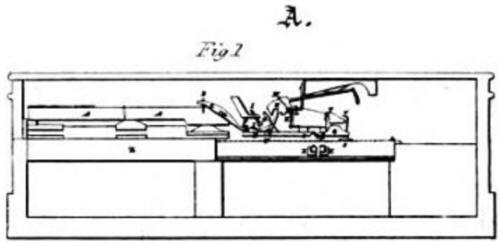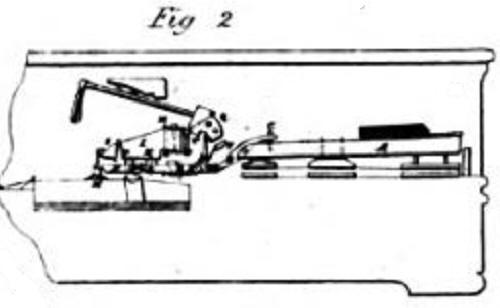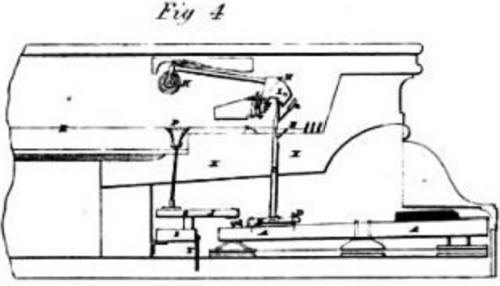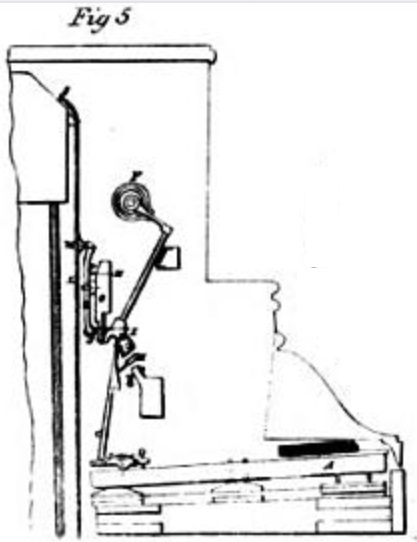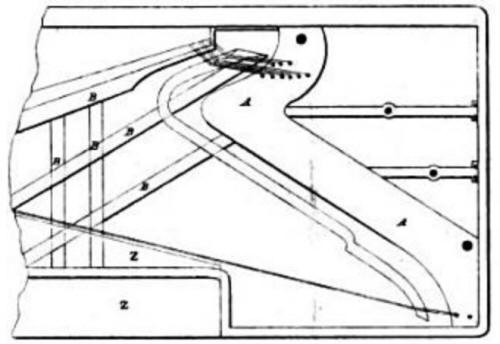home |
Facteurs de pianos en France
FISCHER Pierre Frédéric
Beaufrère de
![]()

![]()
The improvements upon piano-fortes, as described in the Specification of the above Patent, consist principally in causing the hammers to strike from above on the strings." The London Journal of Arts and Sciences, and Repertory of Patent, 1833, p. 233
With An Engraving. To all to whom these presents shall come, &c. &c. — Now know we, that in compliance with the said proviso, I, the said Pierre Frederic Fischer, do hereby declare, that the nature of the said invention, and in what manner the same is to be performed, is particularly described and ascertained by the following description, reference being had to the drawings hereunto annexed, and to the figures and letters marked thereon, (that is to say) : The advantage of this new kind of piano forte consists principally of this; that the hammers striking from above on the strings against the sounding board and bridge, the strings receive the blow from the top, so that they cannot be lifted up by the hammer, and in consequence produce a stronger and clearer sound. The manner in which the strings are placed, tend to prevent their breaking; and from the nature of the construction it will readily be conceived that these pianos will keep longer in tune.
Fig. 1, square piano, A key. B screw with two different taps which regulates the lever c. D the centre of which passes through the key. This lever touches under the hook fixed on the lever which bears the hopper G, and catches under the nut of the hammer H in order to raise it. The screw i serves to push it out of its notch, which effects its escape, K a winding spring mounted on a brass wire, and surmounted by a leather button L, on which the screw M rests, which passes through the nut of the hammer, and serves to regulate the strength of the spring, in order to raise up the hammer by the same spring, N the check which serves to catch the hammer. The piece B has its centre o, and presses, when in action, on a screw P, which is held in another lever Q, the centre of which is in R; at its extremities is the damper s. The hinge piece operates the forte in raising the damper by the hook v. Two moveable pieces x, covered with leather, and dented, placed above the sounding board, and nearly to the strings Y, serve by means of the pedals to damp one or two strings at one's will, and dispense the tuner from damping each cord separately, z the bottom on which the key rests.
Fig. 2, same piano, A key. B the lever regulated by a different tapped screw c. This lever moves in a brass box D, fixed on the piece E, which bears the hopper F, the centre of which is R. This hopper touch is under the notch G, and lets the hammer escape by means of the screw H which passes through the hammer i. The piece B is fixed by a screw K to the hammer-rail; has for its central point L, and raises up the damper M by pressing on the lever N, the centre of which is o. This piece also is fixed on the hammer rail by the screw P. T is a winding spring which serves to raise the hammer by pressing on the screw Q, as is explained in the first figure. The forte is produced by the hinged piece s, as above explained, v check, screwed also in the piece E, serves to catch the hammer after having struck.
Fig. 3, same piano, A key. B double screw which passes through the key, and the piece E which is the continuation of the key, and bears the hopper n, the centre of which is E, and is placed in opposite inclination to the first figure, producing its escape by pressing on the button F, mounted on the screw G, which crosses the hammerrail H. The spring K serves to push back the hopper. The check i placed in the hopper, receives the hammer. At the extremity of the lever is a piece A., with a centre M that bears on its extremity the damper N, which is raised up by the brass wire o, fixed in the piece c, which is the continuation of the key. p is a hinged piece which operates the forte, as before explained, Q a winding spring which serves to raise the hammer K, (as already described). s the centre of the hammer-nut T.
Fig. 4, grand piano forte. The same mechanism as for the square piano, except the alterations required by the difference of the form. In this kind of piano the sounding board is convex at the base, which admits curtailing its length by eighteen inches, without reducing the quality and power of the sound. A key. B a piece bearing the hopper c. Da double screw serving to regulate its height. E another screw passing in the block w, and producing its escape. z check screwed after the hopper, serving to catch the hammer when it has struck, F winding spring mounted on brass wire, and surmounted by a leather button G, on which touches the screw H, which crosses the hammer-nut i, and serving to regulate the strength of the spring, and for raising the hammer K by the same spring. I. is a brass plate which serves to fix the centre M. x a lever bearing the damper P, lifted up by the button a, and producing its operation by moving on its centre o. s a hinged piece, which being drawn down by the pedal T, produces the forte.
Fig. 5, cabinet piano. A key. B the lever which bears the hopper c, and is regulated in height by the double screw ». This hopper c catches under the hammer notch, and by raising the hammer F, touches the button G, which effectuates the escape. H check passing through the hammer-nut Q, bearing on a small wheel J, fixed to the lever K, by moving on its centre L, lifts the damper M placed at the other end. N screw passing through the hammer-rail o, and bearing a winding spring p, which presses against the lever to operate the damping.
Fig. 6, square piano. This figure represents the sounding boards with its carriages on the top, and the rasping block A of cast-iron covered with brass, the inside of which is filled up with wood sheathed with brass, passing over the sounding boards, curtails the length of the strings and then facilitates the turning, B the great bars of the sounding board, which are usually placed below, are above, and screwed from below. By this construction no part of the belly can get unglued even when the instrument is exposed to dampness, z the bottom, on which the frame of the key is placed. In witness whereof, &c." The Repertory of patent inventions, 1833, p. 195, images p. 205
feutre sur les marteaux "[...] The hammer used by Christofori, Silbermann and other early makers consisted of a small wooden block covered with soft leather. With the increase of tone volume the hammer had to undergo changes and we soon find hammers having instead of the block form a longer wedge form, tapering toward the top. To assure firmness, this wedge-like molding was first covered with a piece of firm sole leather, over which a soft piece of sheepskin was glued. Hammers Covered with Leather Next we find larger hammers in which the foundation over the wooden molding was a piece of very hard sole leather a quarter of an inch thick, followed by a medium firm elkskin covering and topped off with a covering of very soft, specially prepared deer or buckskin. The art in hammer making has ever been to obtain a solid, firm foundation, graduating in softness and elasticity toward the top surface, which latter has to be silky and elastic in order to produce a mild, soft tone for pianissimo playing, but with sufficient resistance back of it to permit the hard blow of fortissimo playing. When the iron frame permitted the use of heavier strings, the leather hammer proved insufficient, and we find Alpheus Babcock, of Boston, taking out a patent in 1833 on a hammer covered with felt. Two years later, P. F. Fischer of London (friend of Henri Pape)[lire : beaufrère et probablement tabletier chez Pape] obtained an English patent for piano hammer felt. It is surmised that this patent is really for an invention of Henri Pape of Paris, who at that time experimented with hair felt for hammer covering, cutting up soft beaver hats for that purpose. Getting very good results therewith, but not being able to slice this hairy hat felt thin enough for the treble hammers, Pape induced a hatter to make a hair felt in sheets tapering from a quarter of an inch to one-sixteenth of an inch thick. Pape in 1839 exhibited pianos having hammers covered with such felt, and it seems that the credit for the invention of tapered hammer felt belongs to Pape. Hammers Covered with Leather and Felt We now find the following combination in the hand-made hammers of those days : Directly over the wooden head, a covering of hard sole leather, then elkskin, and over that a covering of hair or wool felt up to about the last two treble octaves, which were covered with buckskin. The elkskin was soon replaced by a firm felt called underfelt, which was not only more economical, but also firmer than elkskin, possessing the required elasticity. Gradually the sole leather was replaced by another under felt, so that we now have the entire hammer made of three thicknesses of felt, each layer of its required firmness. The use of deerskin as a covering for the last two or three octaves was continued, especially in square pianos which had only two strings, more for protection, however, than for tone results.
Felt making
had not advanced sufficiently to produce a material so closely
interknitted as to withstand the cutting of the wires on the thinly
covered treble hammers. About 1835 Wilke, piano maker at Breslau, invented a machine in which a full set of hammers could be covered with felt at one time. It seems that hammers made on this machine were not considered as good as the hand-made, because nearly all European makers continued the hand method until about 1867, when the American pianos, shown at the Paris exposition, made a lasting impression. In America two inventors patented hammer-covering machines in 1850. Rudolf Kreter of New York patented a most ingenious but very complicated machine. Its main fault was that, because of manifold attached springs and levers, it was impossible to use felt over half an inch thick, and the cry was for a larger, heavier hammer. This machine, which had many elements of the present hammer-covering machines, came into possession of Alfred Dolge in 1871, who later on sold it as a curiosity to Brooks of London. [...]" Pianos and their makers, Alfred Dolge, 1911, p. 97-98
"Tout en se servant du feutre, la plupart des facteurs feignent d'ignorer mes titres et mes droits d'inventeur, sous prétexte qu'ils employent un prétendu feutre anglais, qui est blanc, tandis le mien était vert. Cette défaite était cependant fort mal trouvée, car mon invention est également brevetée en Angleterre (1), et le brevet ne mentionne pas de couleur (1) Ce brevet a été délivré à M. Fischer, mon beau-frère." Notice sur les inventions et les perfectionnements de H. Pape, 1845, p. 10 (gallica.bnf.fr)
piano-lyre
"Brevet d'invention de cinq ans en date du 3 juin 1839, déchu par ordannance du roi, le 15 juin 1842, au sieur Fischer (Frédéric), à Paris, pour un piano-lyre. Au sieur Fischer (Frédéric), à Paris, Pour un instrument qu'il nomme piano-lyre. Le piano-lyre ressemble, par sa forme et sa construction, à une guitare, et ne se distingue de ce dernier instrument que par l’absence des cordes, et celle de l’ouverture circulaire pratiquée dans le milieu des guitares. Le piano-lyre est d‘une longueur de 3 pieds, y compris le col, et porte 11 pouces et demi de large, pris du bas de l’instrument. Sur le haut de la carcasse il est appliqué un clavier de 15 pouces de long sur 6 pouces de large, et composé de deux octaves et demie; sa construction ressemble aux claviers ordinaires des pianos. L’exécution de l’instrument s’opère par la pression d’un soufflet appliqué au mécanisme intérieur, et correspondant avec une soupape qui longe le col en ébène de toute son étendue extérieure. La musique est produite par un mécanisme composé de lames en cuivre qui correspondent avec le danierextérieur, et dont les sons se produisent par la pression du soufflet de la main gauche et le toucher du clavier de la droite." Description des machines et procedes specifies dans les brevets d'invention, 1843, p. 203
[Sealed 13th May, 1835.] The subjects of this patent are rather numerous and various, and are extended to a considerable magnitude, both in the description and drawings, without much attention to clearness. We shall, however, consider it sufficient, in this instance, to give but a slight report of the matter, from a conviction that the invention is neither one of general interest, nor are the novel points at all obvious. One of the features is, the construction of the action mechanism to be applied to a pianoforte, in which the tones are produced by the vibrations of metallic springs. These sounding springs may be of a variety of forms, either coiled in helical curves, convolute curves, zigzags, or other bent shapes; or they may be of straight rods, bars, or forks, or a combination of these in various ways. The mode of bracing the framework of the instrument constitutes one feature; and the effect of the touch upon the keys may be varied by an adjustable contrivance. The sounding board is placed in connexion with the head or tympanum of a kettle drum, in order to produce a brilliancy of tone; and the instrument is mounted upon castors, which have helical springs in their sockets, to prevent derangement when moved about. — [Inrolled in the Inrolment Office, November, 1835.]" The London Journal of Arts and Sciences, and Repertory of Patent, 1839, p. 13-14 Pour voir le brevet original voyez le site
Pour les références voyez la page
|
|||
